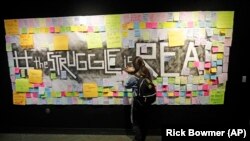More college students are turning to their schools for help with anxiety, depression and other mental health problems.
The Associated Press, or AP, reports that many students must wait weeks for treatment or find help outside the campus community as school clinics struggle to meet demand. This is just one of the findings from an AP study of over 30 public universities in the United States.
Over the past five years, the number of students in the U.S. higher education system has changed little. Yet on some campuses, the number of students seeking treatment for mental health issues has nearly doubled. This increase has been tied to a better understanding of such issues, along with rising rates of depression and other disorders.
Universities have expanded their mental health clinics, but that growth is often slow, and demand keeps rising.
Long waits have led to protests at schools from Maryland to California, in some cases following student suicides. In addition, campus clinics increasingly require their mental health specialists to do more work. However, this can lead to tired, “burned-out” employees.
Jamie Davidson is associate vice president for student wellness at the University of Nevada, Las Vegas. He told The AP his school struggles with large numbers of students who need mental health help. The university has 11 trained counselors for 30,000 students, but her team still finds the work difficult.
“You’re never going to talk to anyone in the mental health field who tells you we have sufficient resources,” Davidson said.
The Associated Press requested five years of records from the largest public university in all 50 states. A total of 39 provided year-by-year data from their counseling clinics or health centers. The records show that most universities are working to expand their mental health services, but many are simply unable to meet demand.
Since 2014, the number of students receiving treatment at the universities has grown by 35 percent. Yet the total number of students attending those schools rose just 5 percent. By last year, nearly 1 in 10 students were coming for help, but the number of trained counselors changed little.
That means one counselor for every 4,000 students on some campuses, including at Utah Valley University. Experts suggest at least one mental health specialist for every 1,500 students, but few of the 39 universities met that benchmark.
One student’s experience
When Ashtyn Aure sought treatment at Utah Valley’s clinic last year, she was suffering anxiety attacks and had not slept for days. Her mind kept returning to painful experiences from her past. When she asked to see a counselor, one worker told her the wait list stretched for months. She left without getting help.
“That was the place I was supposed to go. What do you do after that? Do you go to the hospital? Do you phone a friend?” said Aure.
In the end, she turned to her religious group, which helped her find therapy at an off-campus clinic. “If it wasn’t for that,” she said, “I don’t know.”
Officials at Utah Valley said they are working to avoid such cases. If officials know a student is having serious problems, they said, a counselor can see that person in a few minutes. But workers have only a brief period to make decisions about treatment.
“Unfortunately, stories like this are not uncommon,” said William Erb, senior director of student health services at Utah Valley. “We train, review and revise these procedures so that situations like this can be avoided as much as possible.”
At most universities, students considering suicide or facing other serious issues are offered help right away. Others are asked to make an appointment. For cases that are not urgent, the wait can last from hours to months, depending on the time of year and the design of the clinic.
Many schools that provided data to The AP said it takes weeks to get a first appointment. At Utah Valley, students waited an average of more than four weeks last year. At the University of Washington at Seattle, it was three weeks. During busy times at Louisiana State University, wait times stretched to four or five weeks.
To some students, waiting is just a minor problem. But it raises the risk that some young people will give up on seeking treatment, possibly leading to a worsening of their condition.
At several universities, students have organized campaigns to improve counseling services. But for mental health cases that are not urgent, some argue that waiting is not necessarily bad — and could even lead to better results.
A recent study found greater reductions in anxiety and depression at clinics that provide students ongoing meetings with counselors as opposed to a single meeting when conditions worsen. But under this system, the student might have to wait for a therapist’s caseload to open up.
The rising demand for campus mental health care has been linked to many things. Public recognition of the issue has improved, leading more students to get help. Disorders that once prevented students from going to college are no longer seen as a barrier. Some people believe social media fuels anxiety, while others say the current generation of students simply has more trouble dealing with stress.
Many universities are now rethinking how they provide help, such as offering more short-term treatment programs. More students are being pushed towards group therapy or classes on dealing with anxiety. Counseling centers offer activities like yoga, and many train students to provide emotional help to one another.
Rising demand has also opened doors for businesses promising solutions. Some schools work with services that provide mental health therapy over the telephone or through video meetings. Others urge students to try software programs on their smartphones.
I’m Dorothy Gundy.
And I’m Pete Musto.
Collin Binkley and Larry Fenn reported this story for the Associated Press. Pete Musto adapted it for VOA Learning English. George Grow was the editor.
We want to hear from you. How do colleges and universities in your country deal with student mental health? Write to us in the Comments Section or on our Facebook page.
_________________________________________________________________
Words in This Story
anxiety – n. fear or nervousness about what might happen
campus – n. the area and buildings around a university, college, or school
clinic(s) – n. a place where people get medical help
counselor(s) – n. a person who provides advice as a job
sufficient – adj. having or providing as much as is needed
benchmark – n. something that can be used as a way to judge the quality or level of other, similar things
therapy – n. the treatment of physical or mental illnesses
revise – v. to make changes especially to correct or improve something
procedure(s) – n. an established or accepted way of doing something
appointment – n. an agreement to meet with someone at a particular time
stress – n. a state of mental tension and worry caused by problems in your life or work












